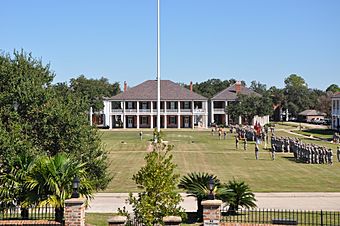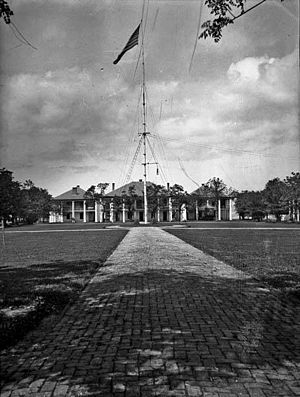Jackson Barracks facts for kids
Quick facts for kids |
|
|
Jackson Barracks
|
|

Jackson Barracks, October 2011. The Washington Artillery on the Parade Field
|
|
| Lua error in Module:Location_map at line 420: attempt to index field 'wikibase' (a nil value). | |
| Location | 6400 St. Claude Avenue, New Orleans, Louisiana |
|---|---|
| Built | 1834 |
| Architect | Various |
| Architectural style | Greek Revival |
| NRHP reference No. | 76000969 |
| Added to NRHP | November 7, 1976 |
Jackson Barracks is a historic military base in New Orleans, Louisiana. It serves as the main office for the Louisiana National Guard. This important place was started in 1834. It was first called "New Orleans Barracks." Later, in 1866, it was renamed to honor Andrew Jackson, a famous general. Jackson Barracks was added to the National Register of Historic Places in 1976 because of its historical importance.
Contents
History of Jackson Barracks
After the War of 1812, the U.S. government realized that cities along the coast needed better protection. So, in 1832, Congress passed a law to build new forts and barracks. This law helped create Jackson Barracks. In 1833, the government bought land in New Orleans to build a new base. This base would support forts like Fort Pike, Fort Macomb, and Fort Jackson, Louisiana.
Lieutenant Frederick Wilkinson designed and oversaw the building of the new base. It was built between 1832 and 1836. The "New Orleans Barracks" could house four infantry companies. It also had a prison, a storage building, and four tall guard towers. The buildings were designed to form a strong wall, with no windows facing outwards. A 10-foot brick wall connected the buildings, making the post very secure. The first soldiers arrived at the barracks in February 1837.
Many famous military leaders stayed at the Barracks over the years. These included Ulysses S. Grant, Robert E. Lee, and George B. McClellan. During the Mexican–American War, the Barracks became a key place for sending and receiving troops. A hospital was built there in 1849 for wounded soldiers returning from Mexico. This was the first public hospital for veterans in the country.
In 1861, Louisiana left the United States. Confederate forces took control of the Barracks. But in 1862, Federal forces recaptured it. On July 7, 1866, the barracks was officially renamed "Jackson Barracks." This honored General Andrew Jackson, who won the Battle of New Orleans.
Three years later, in 1869, the United States organized its "colored troops" into new regiments. The 25th Infantry Regiment, known as the Buffalo Soldiers, was based at Jackson Barracks. These soldiers served the United States in the American Indian Wars and the Spanish–American War.
The 1900s at the Barracks
During World War I, Jackson Barracks was a gathering point for troops. General John J. Pershing even reviewed soldiers there before they left for war. After World War I, the U.S. government gave the property to the State of Louisiana. Major General Raymond Fleming, the head of the Louisiana National Guard, made Jackson Barracks its home.
General Fleming changed the post from an infantry base to a cavalry and artillery base. It housed the 108th Cavalry Regiment and the Washington Artillery. New horse stables were built, and a polo field was created for horse exercises and games.
Over time, the Mississippi River moved closer to the Barracks. In 1912, the river broke through the levee that protected the post. This destroyed the road and train tracks. Parts of the Barracks had to be taken down to build a new levee.
During the Great Depression, Louisiana Governor Huey Long got federal money for state projects. He used the Works Progress Administration (WPA) to renovate Jackson Barracks. A new main office building, "Fleming Hall," was built. It was named after Major General Raymond Fleming.
When the United States entered World War II, the government took control of the barracks again. It was used as a port to send troops overseas. Temporary housing for soldiers replaced the polo field. Jackson Barracks also hosted a conference to plan how to get enough soldiers for the war. This led to the Selective Service Act of 1948. After World War II, the barracks returned to Louisiana.
After World War II
In 1960, a part of Jackson Barracks was used for a work release prison. Later that year, two armories were built. In 1976, Jackson Barracks was added to the National Register of Historic Places. In 1977, the old Powder Magazine was turned into the official Louisiana National Guard Museum. It's called the Ansel M. Stroud, Jr. Military History and Weapons Museum. It has items from many U.S. conflicts.
In 1991, a project started to help the prison at Jackson Barracks. It gained a library and classes for prisoners. However, the prison closed in 1993 after some prisoners escaped. In 1995, the armories were renovated, and the old prison became a police training center.
In 2005, Hurricane Katrina caused massive damage to the entire Jackson Barracks Complex.
Hurricane Katrina's Impact
On August 29, 2005, Hurricane Katrina hit Louisiana as a strong Category 3 storm. The storm surge caused a levee to break near the Industrial Canal. This flooded parts of Jackson Barracks with more than 20 feet of water. People and soldiers had to be rescued by boats and helicopters. The entire complex was almost completely destroyed. The Secretary of the Army, Francis J. Harvey, said that Jackson Barracks was "a very important piece of American history that needs to be preserved."
Rebuilding Jackson Barracks
Congress approved all the money needed for reconstruction. Most of the Barracks had to be rebuilt from scratch. However, the 1837 Old Powder Magazine and 14 old homes were restored. The Federal Emergency Management Agency provided $35 million for this. The whole complex was redesigned. New buildings were made so that important offices and systems were above the first floor.
The Jackson Barracks Historical Renovation project made sure the historical areas were preserved. Teams worked to design new buildings that matched the original Greek Revival style. Many historical buildings were fully renovated, using original materials when possible.
The total cost to rebuild after Hurricane Katrina was $325 million. This included 91 new homes and modern armories. These new buildings have strong features like bomb-proof walls and advanced fire systems. In 2013, the Ansel M. Stroud, Jr. Military History and Weapons Museum reopened. It has new exhibits about Hurricane Katrina and Louisiana soldiers in recent conflicts.
Images for kids



